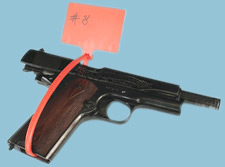Home | Glossary | Resources | Help | Contact Us | Course Map
Archival Notice
This is an archive page that is no longer being updated. It may contain outdated information and links may no longer function as originally intended.
Firearms
General safety procedures should be followed when handling firearms in any environment. Other procedures are unique to the forensic firearms laboratory, including the laboratory firing range and bullet recovery facility.
General Guidelines
The National Rifle Association (NRA) advocates three fundamental safety rules that must be applied simultaneously when handling a firearm:
- Always keep a firearm pointed in a safe direction.
- Always keep your finger off the trigger until ready to shoot.
- Always keep a firearm unloaded until ready to use.
Click here to view the NRA's gun safety rules
These fundamental rules can be expanded to encompass specific procedures recommended by the NRA. It is prudent to practice them in a forensic environment and in any other circumstance. In addition to the NRA rules, all firearms should be treated as if they are loaded until confirmed otherwise.
The NRA rules:
- Be sure a firearm is safe to operate.
- Know how to use the firearm safely.
- Use only the correct ammunition for the firearm.
- Know the target and what is beyond.
- Wear eye and ear protection.
- Never use alcohol or drugs before or while shooting.
- Store firearms so they are not accessible to unauthorized persons.
- Be aware that certain types of firearms and many shooting activities require additional safety precautions.
Unusual firearms, ammunition, and circumstances will likely be encountered in the forensic firearms field. Specific situations require the use of sound judgment to ensure safety.
Additional Online Courses
- What Every First Responding Officer Should Know About DNA Evidence
- Collecting DNA Evidence at Property Crime Scenes
- DNA – A Prosecutor’s Practice Notebook
- Crime Scene and DNA Basics
- Laboratory Safety Programs
- DNA Amplification
- Population Genetics and Statistics
- Non-STR DNA Markers: SNPs, Y-STRs, LCN and mtDNA
- Firearms Examiner Training
- Forensic DNA Education for Law Enforcement Decisionmakers
- What Every Investigator and Evidence Technician Should Know About DNA Evidence
- Principles of Forensic DNA for Officers of the Court
- Law 101: Legal Guide for the Forensic Expert
- Laboratory Orientation and Testing of Body Fluids and Tissues
- DNA Extraction and Quantitation
- STR Data Analysis and Interpretation
- Communication Skills, Report Writing, and Courtroom Testimony
- Español for Law Enforcement
- Amplified DNA Product Separation for Forensic Analysts


